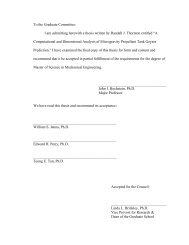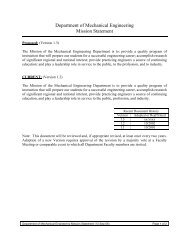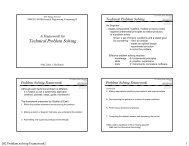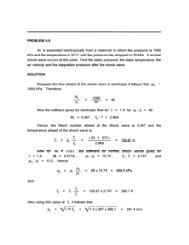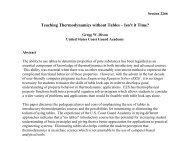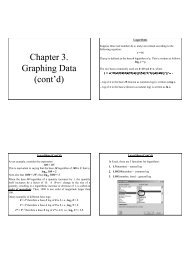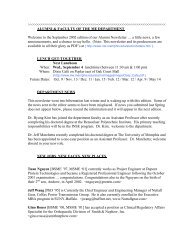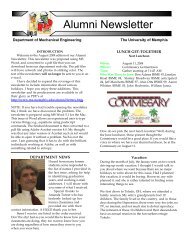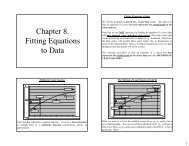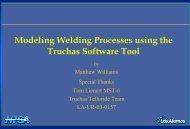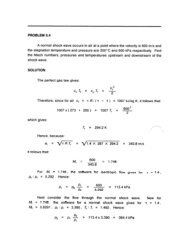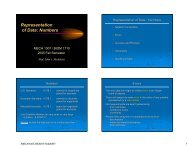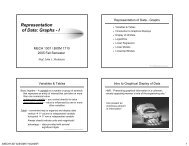MECHANICS of FLUIDS LABORATORY - Mechanical Engineering
MECHANICS of FLUIDS LABORATORY - Mechanical Engineering
MECHANICS of FLUIDS LABORATORY - Mechanical Engineering
You also want an ePaper? Increase the reach of your titles
YUMPU automatically turns print PDFs into web optimized ePapers that Google loves.
EXPERIMENT 2<br />
FLUID PROPERTIES: VISCOSITY<br />
One <strong>of</strong> the properties <strong>of</strong> homogeneous liquids<br />
is their resistance to motion. A measure <strong>of</strong> this<br />
resistance is known as viscosity. It can be<br />
measured in different, standardized methods or<br />
tests. In this experiment, viscosity will be<br />
measured with a falling sphere viscometer.<br />
The Falling Sphere Viscometer<br />
When an object falls through a fluid medium,<br />
the object reaches a constant final speed or<br />
terminal velocity. If this terminal velocity is<br />
sufficiently low, then the various forces acting on<br />
the object can be described with exact expressions.<br />
The forces acting on a sphere, for example, that is<br />
falling at terminal velocity through a liquid are:<br />
Weight - Buoyancy - Drag = 0<br />
ρ s g 4 3 πR3 - ρg 4 3 πR3 - 6πµVR = 0<br />
where ρ s and ρ are density <strong>of</strong> the sphere and<br />
liquid respectively, V is the sphere’s terminal<br />
velocity, R is the radius <strong>of</strong> the sphere and µ is<br />
the viscosity <strong>of</strong> the liquid. In solving the<br />
preceding equation, the viscosity <strong>of</strong> the liquid can<br />
be determined. The above expression for drag is<br />
valid only if the following equation is valid:<br />
average the results. With the terminal velocity<br />
<strong>of</strong> this and <strong>of</strong> other spheres measured and known,<br />
the absolute and kinematic viscosity <strong>of</strong> the liquid<br />
can be calculated. The temperature <strong>of</strong> the test<br />
liquid should also be recorded. Use at least three<br />
different spheres. (Note that if the density <strong>of</strong><br />
the liquid is unknown, it can be obtained from any<br />
group who has completed or is taking data on<br />
Experiment 1.)<br />
Questions<br />
1. Should the terminal velocity <strong>of</strong> two<br />
different size spheres be the same?<br />
2. Does a larger sphere have a higher<br />
terminal velocity?<br />
3. Should the viscosity found for two different<br />
size spheres be the same? Why or why not?<br />
4. If different size spheres give different<br />
results for the viscosity, what are the error<br />
sources? Calculate the % error and account<br />
for all known error sources.<br />
5. What are the shortcomings <strong>of</strong> this method?<br />
6. Why should temperature be recorded.<br />
7. Can this method be used for gases?<br />
8. Can this method be used for opaque liquids?<br />
9. Can this method be used for something like<br />
peanut butter, or grease or flour dough?<br />
Why or why not?<br />
ρVD<br />
µ < 1<br />
where D is the sphere diameter. Once the<br />
viscosity <strong>of</strong> the liquid is found, the above ratio<br />
should be calculated to be certain that the<br />
mathematical model gives an accurate<br />
description <strong>of</strong> a sphere falling through the<br />
liquid.<br />
Equipment<br />
Hydrometer cylinder<br />
Scale<br />
Stopwatch<br />
Several small spheres with weight and<br />
diameter to be measured<br />
Test liquid<br />
FIGURE 2.1. Terminal velocity measurement (V =<br />
d/time).<br />
V<br />
d<br />
Drop a sphere into the cylinder liquid and<br />
record the time it takes for the sphere to fall a<br />
certain measured distance. The distance divided<br />
by the measured time gives the terminal velocity<br />
<strong>of</strong> the sphere. Repeat the measurement and<br />
9



